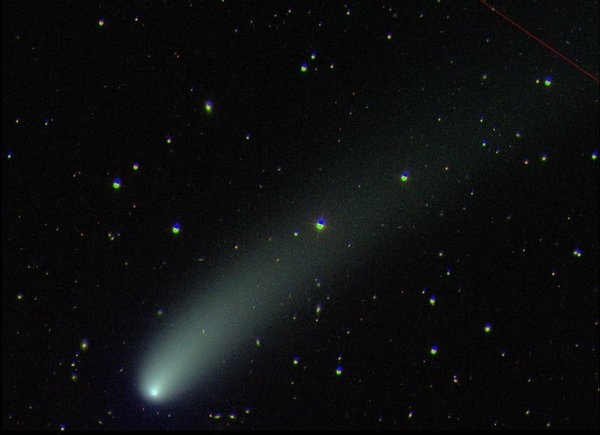.
An enormous asteroid or comet smashing into the Earth 65 million years ago killed off the dinosaurs. But, according to a new study by US scientists, published in the wake of an impact event on Jupiter, cometary collisions with Earth probably didn’t cause any more than one other extinction event during life’s history.
US researchers have looked to the Oort Cloud to help them work out just how many comets may have struck the earth during the time complex life has existed. The Oort Cloud is a remnant of the nebula from which the solar system formed 4.5 billion years ago. It starts about 93 billion miles from the sun (a thousand times as far from the sun as the Earth) and stretches to an incredible three light years away. It is thought that the Oort Cloud contains billions of comets but most are so small and distant that we will never see them.
Now, Thomas Quinn, Nathan Kaib and colleagues at the University of Washington, have used computer models to simulate the evolution of comet clouds in the solar system over the last 1.2 billion years. They found that even outside the periods of comet showers, the inner Oort Cloud was a major source of long-period comets. Some of these can cross Earth’s path but the simulations show that no more than two or three comets could have struck the Earth even during the most powerful comet shower of the last 500 million years.
Astronomers have known for some time that the inner solar system of rocky planets – Earth, Mars, Venus, and Mercury – is protected from comets by the gas giants Saturn and Jupiter. The enormous gravitational fields of these planets essentially eject comets into interstellar space or act as traps for them. This latter point was reinforced on 20th July when a huge scar appeared on Jupiter’s surface, likely evidence of a cometary impact.
There are about 3,200 known long-period comets of which Hale-Bopp is perhaps the most famous as it was visible with the naked eye for much of 1996 and 1997. Some long-period comets take thousands if not millions of years to make a single orbit of the sun. Comet Halley by contrast, which reappears every 75 years, is a short-period comet, which originate in a different part of the solar system known as the Kuiper Belt and are much more predictable. The computer simulation by Quinn and colleagues assumed that the inner Oort Cloud is the only source of potentially dangerous long-period comets.

“For the past 25 years, the inner Oort Cloud has been considered a mysterious, unobserved region of the solar system capable of providing bursts of bodies that occasionally wipe out life on Earth,” Quinn explains, “We have shown that comets already discovered can actually be used to estimate an upper limit on the number of bodies in this reservoir.”
With three major impacts taking place almost simultaneously, researchers had suggested that the minor extinction event of 40 million years ago resulted from a comet shower. Kaib and Quinn’s research implies that if that relatively minor extinction event was caused by a comet shower, then that was probably the most-intense comet shower since the fossil record began.
Further resources
Science Express, 2009, Jul 30, online
Comet shower movie from Nathan Kaib